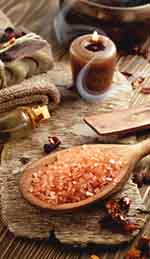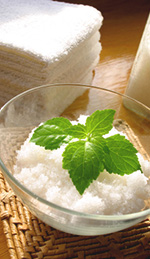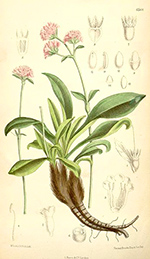 India is one of the epicenters of herbal medicine, with an Ayurvedic tradition that is thousands of years old, so it’s no surprise that Indian natural essential oils are some of the most highly valued in aromatherapy. At the Essential Oil Exchange, we strive to honor the historical and cultural context of the essential oils we offer. Below, we take a closer look at the four Indian natural essential oils that have stood the test of time as healing agents in Ayurveda and beyond.
India is one of the epicenters of herbal medicine, with an Ayurvedic tradition that is thousands of years old, so it’s no surprise that Indian natural essential oils are some of the most highly valued in aromatherapy. At the Essential Oil Exchange, we strive to honor the historical and cultural context of the essential oils we offer. Below, we take a closer look at the four Indian natural essential oils that have stood the test of time as healing agents in Ayurveda and beyond.
Sandalwood: (Santalum album) Sandalwood is a parasitic evergreen tree with smooth, brownish gray bark and small purple or white flowers. Extremely long lived, sandalwood trees must be allowed to reach at least 30 years of age (and preferably 60 years) before their wood can be harvested. Also called aloeswood in the Hindu scriptures, the woody-balsamic aroma of sandalwood essential oil has been associated with feelings of the sacred and is commonly used in meditation to ground the psyche and create a sense of being connected to the universe. Sandalwood oil is also burned in Hindu temples and used as an anointing oil to open the third eye chakra—the center of intuition, clairvoyance, and imagination.
Therapeutically, sandalwood essential oil can work wonders in balancing skin that is either too dry or too oily [1]. The oil may also soothe sensitive or irritated skin, reduce the appearance of stretch marks and scars [1], elevate mood, and increase mental focus [2]. It is also notably used as an aphrodisiac [2], along with jasmine and patchouli oil.
Vetiver: (Vetiveria zizanoides) A hardy grass whose roots anchor the soil around rivers and watercourses, vetiver is also the source of a thick, viscous essential oil. Vetiver essential oil, distilled from the plant’s fibrous roots, is used in up to 25% of all Western perfumes both as a fixative and for its slightly sweet, earthy, almost animalic scent. In India, screens and mats woven from vetiver grass are used to repel insects; water can also be sprinkled on vetiver grass screens to create fragrant, cooling breezes.
Vetiver oil is used in aromatherapy to ease states of nervousness, promote calm, and address occasional sleeplessness [3]. Aromatherapists have even explored the calming effects of vetiver oil for panic attacks and and flashbacks [4]. In massages, the oil may be used as a tonic for mature skin, to speed wound healing and reduce scarring, and to treat eczema and irritated skin [3]. The smell of vetiver oil acts to open the root chakra, increasing feelings of groundedness and security.
Patchouli: (Pogostemon cablin) Anyone familiar with the hippy era of the ‘60s is probably also familiar with patchouli essential oil. Though it became popular in that back-to-nature era as an earthy fragrance with aphrodisiac qualities, patchouli has an even longer history in India. Patchouli is a large herbaceous shrub in the mint family, with serrated green leaves and small white or pink flowers. Its name probably comes from the Sanskrit words patch and ilai, together meaning “green leaf”. Patchouli leaves were used as a wound poultice in India because of their antiseptic and anti-infectious properties [5], and were also placed in clothing chests to drive off textile moths. During British rule in India, clothing imports often came packed with patchouli leaves to protect them enroute; as the fragrance became associated with expensive Asian goods, merchants started scenting their wares with patchouli oil to give them a more “exotic” feel—even if they weren’t imported!
Like most other Indian natural essential oils, patchouli oil has a roster of benefits for the skin, including toning mature skin to reduce the appearance of fine lines and wrinkles, and moisturizing dry skin [6]. The scent of patchouli oil is rich and earthy: just inhaling it can have positive calming and stress-reducing effects [6]. For this reason, patchouli oil can also be used to center the mind before meditation. Patchouli opens the heart and sacral chakras, enabling the practitioner to let go of obsessions, jealousies and insecurities.
Spikenard: (Nardostachys jatamansi) Sometimes called Indian valerian because of its similar calming properties, the aromatic roots of spikenard have been used as an incense by Buddhist monks and Nepalese shamans literally for thousands of years. A montane plant native to the Himalayas between altitudes of 11,000 and 17,000 feet, spikenard has been used in India as a perfume, skin tonic, and medicinal plant for supporting the immune system [7]. Spikenard has an especially long spiritual history in both South Asia and the West: spikenard oil appears in the Bible multiple times, most notably as an ingredient in the ointment used to anoint Jesus’ feet at the Last Supper.
Spikenard essential oil is frequently added to valerian root essential oil as an adulterant, since the oils have very similar therapeutic actions. In aromatherapy, spikenard oil soothes the mind and helps one to let go of the need for control, a common side effect of a strong will. Spikenard’s grounding effect on the psyche can combat occasional sleeplessness, while its anti-inflammatory and anti-spasmodic effects are valued in treating migraines and headaches, irritated skin, allergic skin reactions and rashes, wounds, and even dandruff [8]. Used in a meditative practice, spikenard essential oil opens the heart and solar plexus chakras, helping one to be comfortable in their own skin and relax into the present moment.
REFERENCES
1.Keville, Kathy. “Aromatherapy: Sandalwood” HowStuffWorks. Accessed May 16th, 2014. http://health.howstuffworks.com/wellness/natural-medicine/aromatherapy/aromatherapy-sandalwood.htm.
2. Wong, Cathy ND. “Sandalwood Essential Oil: What You Need to Know.” Alternative Medicine: About. com. http://altmedicine.about.com/od/aromatherapy/a/Sandalwood-Essential-Oil.htm.
3. “Vetiver Essential Oil: Benefits and Uses”. AromaWeb. Accessed May 15th, 2014. http://www.aromaweb.com/essential-oils/vetiver-oil.asp.
4. “Post-Traumatic Stress Disorder”. West Coast Institute of Aromatherapy. Accessed May 16th, 2014. http://www.westcoastaromatherapy.com/free-information/articles-archive/post-traumatic-stress-disorder/.
5. Das, Kuntal, Nilesh K. Gupta, S. Vijayabhaskar, and U.M. Manjunath. April-June 2011. “Antimicrobial potential of patchouli oil cultivated under acidic soil zone of South India.” Indian Journal of Novel Drug Delivery 3 (2):104-111.
6. “Patchouli Oil Benefits”. Patchouli Plant .com. Accessed May 14th, 2014. http://www.patchouliplant.com/patchouli-benifits.html.
7. Rowan, Tiffany. “How to Build Your Immune System With Essential Oils.” Accessed May 16th, 2014. http://tiffanyrowan.com/essentialoils/how-to-build-your-immune-system-with-essential-oils-before-the-cold-and-flu-season-hits/.
8. “Health Benefits of Spikenard Essential Oil”. Organic Facts. Accessed May 15th, 2014. http://www.organicfacts.net/health-benefits/essential-oils/health-benefits-of-spikenard-essential-oil.html.




